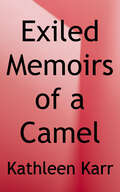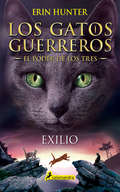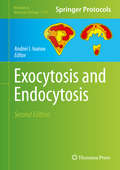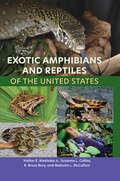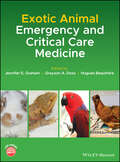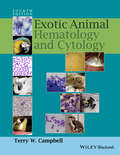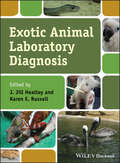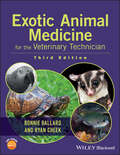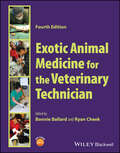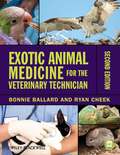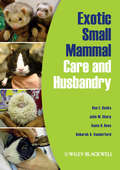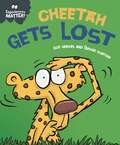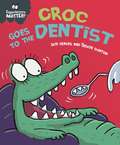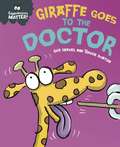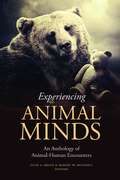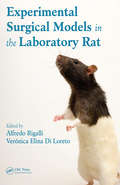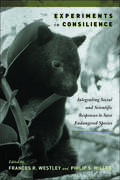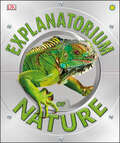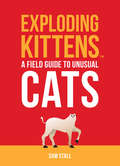- Table View
- List View
Exiled: Memoirs of a Camel
by Kathleen KarrIn the nineteenth century, Ali the camel is separated from his mother in Egypt and sent to Texas, where he becomes part of the United States Camel Corps, but does not forget his longing for sand dunes and freedom.
Exilio: . (Los Gatos Guerreros | El Poder de los Tres #Volumen 3)
by Erin HunterExilio, cuarta entrega de la saga «Los Gatos Guerreros | El Poder de los Tres», contiene batallas emocionantes, y más aventura e intriga que nunca. Único aprendiz del Clan del Trueno que conoce la oscura profecía que determina tanto su vida como la de Leonino y Carrasquera, sus hermanos guerreros, Glayino se siente fascinado por el poder que este conocimiento puede otorgarle. Por ello, decide indagar en el pasado lejano, en la historia de los gatos ya fallecidos que antaño caminaron por esos mismos bosques y ahora acechan sus sueños. La búsqueda de respuestas apunta hacia el hogar de la Tribu de las Aguas Rápidas, y como sea que Carrasquera y Leonino también quieren ir a las montañas, aunque por razones distintas, los tres hermanos se unen a un grupo de gatos de los cuatro clanes y juntos emprenden un viaje que los ha de conducir a la revelación de los secretos que guardan las claves de su destino. «El Poder de los Tres» es la tercera saga de «Los Gatos Guerreros», una serie que se ha traducido ya a 36 idiomas, lleva vendidos más de 30 millones de ejemplares en todo el mundo y ha permanecido durante más de dos años en la lista de grandes éxitos de The New York Times.
Exocytosis and Endocytosis
by Andrei I. IvanovIn this book, skilled experts provide the most up-to-date, step-by-step laboratory protocols for examining molecular machinery and biological functions of exocytosis and endocytosis in vitro and in vivo. The book is insightful to both newcomers and seasoned professionals. It offers a unique and highly practical guide to versatile laboratory tools developed to study various aspects of intracellular vesicle trafficking in simple model systems and living organisms.
Exogenous Enzymes as Feed Additives in Ruminants
by Abdelfattah Zeidan Mohamed Salem Abubeker Hassen Uchenna Y. AneleThis book addresses a global issue of increasing high quality food from ruminant animals while reducing their impacts on the environment. However, one of the main constraints to livestock development and the underlying cause of the low productivity in many developing countries is inadequate nutrition associated with inefficient utilization of forages and fibrous feed resources. In many countries, fibrous feed makes up the bulk of available feed resource base, which is characterized by scarcity and fluctuating supply in the quantity and quality of feed resources, nutrient imbalance as seen in many native pastures, grasslands and crop residues-based feeding systems with limited use of commercial concentrate feeds such as soybean, cottonseed and groundnut meals, etc. Furthermore, the production of methane, an important greenhouse gas (GHG), from ruminants fed highly fibrous diets such as straws and stover is higher than those animals fed better quality forages or concentrate diets. Recent research shows that supplementing livestock diets with exogenous fibre degrading enzymes can improve feed utilization by enhancing intake, fibre degradation in the rumen and overall digestibility of fibrous feeds which in turn leads to improved animal performance, farmers’ income, and a reduction in GHG emissions. The book editors would like to acknowledge the Joint FAO/IAEA Division of Nuclear Techniques in Food and Agriculture for funding part of the studies that make up some of these chapters and were part of the final reports of a coordinated research project financed by IAEA.
Exotic Amphibians and Reptiles of the United States
by Walter E. Meshaka Jr. Suzanne L. Collins R. Bruce Bury Malcolm L. McCallumThe first complete field guide to the exotic amphibians and reptiles established in the continental United States and Hawaiʻi, this volume covers 74 species that are not native to the country and 29 species that are native but occur beyond their original geographic range. Dispersed from their former habitats by human activity, many of these species are invasive in their new environments, causing ecological or economic harm. Ideal for naturalists of all levels, Exotic Amphibians and Reptiles of the United States details each species’ taxonomy, distribution, history, and ecology and portrays each one with vibrant photographs. Drawing on county-level distribution maps from 2,908 published records, this guide provides an in-depth understanding of local factors that drive the success of exotic species. It connects species-specific information to conservation issues as it explores human causes of exotic and invasive establishment. The book also includes eight invited essays which provide regional perspectives on scientific, economic, and management-related aspects of this phenomenon. As ecological pressures on native species and habitats increase, understanding the histories and roles of exotic species is becoming more and more important for conservation efforts. Providing practical identification skills and an awareness of the environmental impacts of these amphibians and reptiles, this indispensable guide equips readers to confront the unusual biodiversity crisis of exotic species.
Exotic Animal Emergency and Critical Care Medicine
by Jennifer E. Graham Grayson A. Doss Hugues Beaufr ReExotic Animal Emergency and Critical Care Medicine delivers the most relevant and current information required by general veterinary practitioners and veterinary specialists in treating emergent and critical exotic patients. Covering the management of common emergency presentations in exotic companion mammals, birds, reptiles, and amphibians, each section discusses triage and stabilization, diagnostics, nutrition and fluid therapy, analgesia, anesthesia, monitoring, CPR, and euthanasia. The book includes quick reference tables, species-specific drug formularies, and illustrations of exotic animal emergency procedures and techniques. The information contained within is based on an extensive review of the most current literature and the combined knowledge and expertise of international leaders in the field of exotic animal medicine and surgery. A one-stop resource like no other, Exotic Animal Emergency and Critical Care Medicine makes it easy to find the information needed to effectively treat urgent and life-threatening conditions in pet exotic animals. The book covers a wide range of species, encompassing: Exotic companion mammals, including ferrets, rabbits, guinea pigs, chinchillas, rats, mice, hamsters, gerbils, hedgehogs, and sugar gliders Birds, including psittacines, passerines, doves and pigeons, as well as backyard poultry and waterfowl Reptiles, including turtles and tortoises, snakes and lizards Amphibians Equally useful for general practitioners, specialists in emergency and critical care and exotic animal medicine, veterinary students, and trainees, Exotic Animal Emergency and Critical Care Medicine is an essential resource for the emergent and critical care of exotic animals.
Exotic Animal Hematology and Cytology
by Terry W. Campbell Krystan R. GrantThe newly revised Fifth Edition of Exotic Animal Hematology and Cytology delivers a fully updated new edition of the most complete reference to hematology and cytology in exotic animals. The book features high-quality images and step-by-step descriptions of practical techniques. Organized by animal class to make it easier to quickly find critical information, the authors have included 45 new case studies to highlight the application of the content in a real-world setting. All major exotic animal groups are covered, including mammals, birds, reptiles, amphibians, and fish. Clinicians seeking a decision-making aid for patient workup, treatment, and prognosis will find what they need in Exotic Animal Hematology and Cytology. The book also includes: Thorough cellular descriptions unique to mammalian, avian, herptile, and fish species, with extensive discussions of blood and bone marrow sample collection and hematologic techniques for each group Comprehensive evaluation of the peripheral blood specific to mammals, birds, herptiles, and fish, as well as the evaluation of bone marrow Practical discussions of hematology case studies with applications to common real-world clinical problems Color atlas of hemic cells of select species for quick and easy reference Extensive examinations of cytodiagnosis and exploration of unique features within mammals, birds, herptiles, and fish, as well as cytology case studies and wet-mount cases in fish Access to video clips and additional case reports on a companion website Exotic Animal Hematology and Cytology is an essential reference for veterinary clinical pathologists, anatomic pathologists, clinicians, and technicians, as well as for veterinary students taking courses involving exotic hematology and cytology.
Exotic Animal Hematology and Cytology
by Terry W. CampbellExotic Animal Hematology and Cytology, Fourth Edition updates the most comprehensive reference available on exotic animal hematology and cytology of all major species. Acts as both an atlas and a text, offering high-quality photographs and step-by-step descriptions of techniques associated with preparing and interpreting hematology and cytology samples Presents complete information on hematology and cytology in a wide range of exotic species, including small mammals, birds, reptiles, amphibians, and fish Includes more than 700 high-quality color photographs, now with sizing bars Takes a new disease-based structure for improved ease of use Provides straightforward step-by-step descriptions of sample preparation and interpretation
Exotic Animal Laboratory Diagnosis
by J. Jill Heatley Karen E. RussellExotic Animal Laboratory Diagnosis is a practical, user-friendly guide to diagnostic testing in a wide range of exotic species. Offers complete information on obtaining samples, performing tests, and interpreting laboratory results in exotic animals Presents information on each species using a similar format for easy access Emphasizes details on clinical biochemistries, urinalysis, and common laboratory diagnostic tests not found in other resources Draws together information on selecting, performing, and using diagnostic tests into a single easy-to-use resource Covers a wide range of species, including small mammals, primates, reptiles, aquatic animals, and wild, laboratory, and pet birds
Exotic Animal Medicine for the Veterinary Technician
by Ryan Cheek Bonnie BallardExotic Animal Medicine for the Veterinary Technician, Second Edition is a comprehensive yet clear introduction to exotic animal practice for technicians in the classroom and clinic setting alike. With an emphasis on the exotic species most likely to present to a veterinary practice, the book offers easy-to-follow descriptions of common procedures and techniques. Covering information ranging from anatomy, restraint, and common diseases to radiology, surgical assisting, and parasitology, Exotic Animal Medicine for the Veterinary Technician provides technicians with all the information necessary to confidently and competently treat exotic patients. This book's companion Web site includes review questions and figures for download in PowerPoint at www.wiley.com/go/ballard.
Exotic Animal Medicine for the Veterinary Technician
by Ryan Cheek Bonnie BallardExotic Animal Medicine for the Veterinary Technician Comprehensive full color textbook on common exotic species, written specifically for vet techs in classroom or clinical settings Now in its fourth edition, Exotic Animal Medicine for the Veterinary Technician is a comprehensive yet clear introduction to exotic animal practice for veterinary technicians in the classroom and clinical settings alike. With an emphasis on the exotic species most likely to find their way to a veterinary practice, the book offers coverage of birds, reptiles, amphibians, exotic companion mammals, and wildlife. It also features discussions of anatomy, restraint, common diseases, radiology, anesthesia and analgesia, clinical skills, surgical assisting, and parasitology. This edition offers new updates throughout, including new chapters related to critical care feeding of exotic companion mammals, reptile infectious diseases, and exotic animal rehabilitation. It also provides full-color photos, including radiographs. Designed to provide technicians with all the information necessary to confidently and competently treat exotic patients, Exotic Animal Medicine for the Veterinary Technician offers easy-to-follow descriptions of common procedures and techniques. A companion website delivers review questions and images from the book in PowerPoint format. Topics covered in Exotic Animal Medicine for the Veterinary Technician include: Herpetoculture and reproduction, covering captive bred versus wild caught, quarantining, methods of sex determination, and reproductive behavior Criteria to determine water quality for fish, including pH, oxygen, temperature, chlorine and chloramine, and salinity Clinical techniques for degus, including oral (PO), subcutaneous (SC), intramuscular (IM), intraperitoneal (IP), catheter placement, and wound managementRole of the veterinary technician in wildlife rehabilitation, covering clinical protocols, intake procedures, ethical considerations, and choosing treatment routes Exotic Animal Medicine for the Veterinary Technician is an essential reference for veterinary technician students, along with veterinary technicians working in an exotic practice, or veterinary technicians who work in a small animal practice where adding exotic patients is being considered.
Exotic Animal Medicine for the Veterinary Technician (2nd Edition)
by Bonnie M. Ballard Ryan CheekExotic Animal Medicine for the Veterinary Technician, Second Edition is a comprehensive yet clear introduction to exotic animal practice for technicians in the classroom and clinic setting alike. With an emphasis on the exotic species most likely to present to a veterinary practice, the book offers easy-to-follow descriptions of common procedures and techniques. Covering information ranging from anatomy, restraint, and common diseases to radiology, surgical assisting, and parasitology, Exotic Animal Medicine for the Veterinary Technician provides technicians with all the information necessary to confidently and competently treat exotic patients. This book's companion Web site includes review questions and figures for download in PowerPoint.
Exotic Small Mammal Care and Husbandry
by Sonia D. Doss Deborah A. Vanderford Ron E. Banks Julie M. SharpExotic Small Mammal Care and Husbandry is a practical reference for assessing, handling, and treating small exotic animals in the veterinary clinic. Covering common species such as mice, hamsters, rabbits, and ferrets, the book focuses on nursing care, giving veterinary staff the information they need to work with these less-common patients. With information on basic anatomy, preventative care, and common diseases, Exotic Small Mammal Care and Husbandry provides a thorough grounding in the fundamentals of caring for small exotic mammals and communicating with owners.
Experiences Matter: Cheetah Gets Lost (Experiences Matter)
by Sue GravesCheetah Gets Lost offers a gentle introduction to the experience of getting lost for young children.This funny, charming story is the perfect way to introduce young children to the experience of getting lost. Also included are suggestions for activities and ideas to talk through together to help children reflect on their own experiences.When Cheetah gets lost on a day out with his friends and Uncle Hippo, he must try to keep calm and remember what to do to stay safe and find help.The Experiences Matter series of picture books provide a gentle means of discussing experiences, boosting self-esteem and reinforcing good behaviour. Supports the Personal, Social and Emotional Development Area of Learning in the Early Years Foundation Stage, and is also suitable for use with children in KS1 and can be used to discuss values. Suitable for children under 5.
Experiences Matter: Croc Goes to the Dentist (Experiences Matter)
by Sue GravesCroc Goes to the Dentist offers a gentle introduction to the experience of visiting the dentist for young children.This funny, charming story is the perfect way to introduce young children to the experience of visiting the dentist. Also included are suggestions for activities and ideas to talk through together to help children reflect on their own experiences.Crocodile loves sweet things, but when her teeth start to hurt, she needs to visit the dentist. Crocodile feels nervous, but the dentist is very kind.The Experiences Matter series of picture books provide a gentle means of discussing experiences, boosting self-esteem and reinforcing good behaviour. Supports the Personal, Social and Emotional Development Area of Learning in the Early Years Foundation Stage, and is also suitable for use with children in KS1 and can be used to discuss values. Suitable for children under 5.
Experiences Matter: Giraffe Goes to the Doctor (Experiences Matter)
by Sue GravesGiraffe Goes to the Doctor offers a gentle introduction to the experience of visiting the doctor for young children.This funny, charming story is the perfect way to introduce young children to the experience of visiting the doctor. Also included are suggestions for activities and ideas to talk through together to help children reflect on their own experiences.Giraffe is not feeling well. She has a hot head and a sore throat. Mum says Giraffe will need to visit the doctor. Giraffe feels nervous, but the doctor is very gentle and she is soon feeling better.The Experiences Matter series of picture books provide a gentle means of discussing experiences, boosting self-esteem and reinforcing good behaviour. Supports the Personal, Social and Emotional Development Area of Learning in the Early Years Foundation Stage, and is also suitable for use with children in KS1 and can be used to discuss values. Suitable for children under 5.
Experiencing Animal Minds: An Anthology of Animal-Human Encounters
by Robert W. Mitchell. Julie A. SmithIn these multidisciplinary essays, academic scholars and animal experts explore the nature of animal minds ad the methods humans conventionally and unconventionally use to understand them. The collection features chapters by scholars working in psychology, sociology, history, philosophy, literary studies, and art as well as chapters by or about people who live or work with animals, including the founder of a sanctuary for chickens, a fur trapper, a popular canine psychologist, a horse trainer, and an art photographer who captures everyday contact between humans and their animal companions.
Experiencing Animal Minds: An Anthology of Animal-Human Encounters (Critical Perspectives on Animals: Theory, Culture, Science, and Law)
by Robert W. Mitchell. Julie A. Smith EdsIn these multidisciplinary essays, academic scholars and animal experts explore the nature of animal minds and the methods humans conventionally and unconventionally use to understand them. The collection features chapters by scholars working in psychology, sociology, history, philosophy, literary studies, and art, as well as chapters by and about people who live and work with animals, including the founder of a sanctuary for chickens, a fur trapper, a popular canine psychologist, a horse trainer, and an art photographer who captures everyday contact between humans and their animal companions.Divided into five sections, the collection first considers the ways that humans live with animals and the influence of cohabitation on their perceptions of animals' minds. It follows with an examination of anthropomorphism as both a guide and hindrance to mapping animal consciousness. Chapters next examine the effects of embodiment on animals' minds and the role of animal-human interembodiment on humans' understandings of animals' minds. Final sections identify historical representations of difference between human and animal consciousness and their relevance to pre-established cultural attitudes, as well as the ways that representations of animals' minds target particular audiences and sometimes produce problematic outcomes. The editors conclude with a discussion of the relationship between the book's chapters and two pressing themes: the connection between human beliefs about animals' minds and human ethical behavior, and the challenges and conditions for knowing the minds of animals. By inviting readers to compare and contrast multiple, uncommon points of view, this collection offers a unique encounter with the diverse perspectives and theories now shaping animal studies.
Experimental Design and Reproducibility in Preclinical Animal Studies (Laboratory Animal Science and Medicine #1)
by José M. Sánchez Morgado Aurora BrønstadThis highly-readable text provides grounds on how to plan and conduct animal experiments that can be reproduced by others. The book touches on factors that may impact the reproducibility of animal studies including: the animal genetic background, the animal microbial flora, environmental and physiological variables affecting the animal, animal welfare, statistics and experimental design, systematic reviews of animal studies, and the publishing process. The book addresses advanced undergraduates, graduate students and all scientists working with animals.
Experimental Surgical Models in the Laboratory Rat
by Alfredo Rigalli Verónica Elina Di LoretoAn All-Inclusive Guide to Surgical Techniques on RatsThe design of an adequate surgical model, like the choice of the animal model itself, is extremely important for obtaining reliable valuable data. Experimental Surgical Models in the Laboratory Rat summarizes a series of techniques that were applied in the Bone Biology Laboratories, School of Medicine, Rosario National University, Argentina. Stopping just short of an exhaustive analysis of the techniques, this manual describes the basics of each surgical technique, the necessary materials, precautions to consider, the methodology to apply, and the possible results to be obtained in similar experiments.CD-ROM: 250 Illustrations of Surgery Techniques with Step-by-Step InstructionWith succinct descriptions, color photographs, and easy-to-follow steps, the downloadable resources are a practical, full-color roadmap for performing various surgery techniques, such as catheterization, tracheostomy, intramuscular injection, subcutaneous injection, intraperitoneal injection, and oral intubation. This definitive work provides technical and practical data including volumes and concentrations of solutions, catheters used, equipment, and biological variables on the rat. Experimental Surgical Models in the Laboratory Rat is a complete reference for today’s biomedical sciences investigator.
Experimenting with Humans and Animals: From Galen to Animal Rights (Johns Hopkins Introductory Studies In The History Ser.)
by Anita GuerriniExperimentation on animals and particularly humans is often assumed to be a uniquely modern phenomenon. But the ideas and attitudes that encourage the biological and medical sciences to experiment on living creatures date from the earliest expression of Western thought. <p><p> In Animal and Human Experimentation, the author looks at the history of these practices from vivisection in ancient Alexandria to present-day battles over animal rights and medical research employing human subjects. The author discusses in-depth key historical episodes in the use of living beings in science and medicine, including the discovery of blood circulation, the development of smallpox and polio vaccines, and recent AIDS research. <p><p> She also explores the rise of the antivivisection movement in Victorian England, the modern animal rights movement, and current debates over gene therapy. In this highly accessible text, we learn how our understanding of an animal's capacity to feel pain has evolved. The author reminds us that the ethical values of science seldom stray far from those of the society in which scientists live and work. Ethical questions about the use of animals and humans in research remain among the most vexing within both the scientific community and society at large. These often rancorous arguments have gone on, however, with little awareness of their historical antecedents. <p><p> Animal and Human Experimentation offers students and concerned general readers on every side of this debate a context within which to understand more fully the responsibility we all bear for the suffering inflicted on other living beings in the name of scientific knowledge.
Experiments in Consilience: Integrating Social And Scientific Responses To Save Endangered Species
by Frances Westley Philip S. MillerIn his 1998 book Consilience, E.O. Wilson set forth the idea that integrating knowledge and insights from across the spectrum of human study -- the humanities, social science, and natural sciences -- is the key to solving complex environmental and social problems. Experiments in Consilience tells the unique story of a pathbreaking effort to apply this theoretical construct in a real-world setting. The book describes the work of the Biodiversity Research Network, a team of experts from the United States and Canada brought together to build interdisciplinary connections and stimulate an exchange of expertise. Team members sought to understand the ecology and population dynamics of key species in particular ecosystems, to understand the impact of human populations on those species and ecosystems, and to develop tools and processes for involving a greater variety of stakeholders in conservation efforts. In order to keep the experiment grounded, the network focused on a single type of conservation planning workshop run by a single organization -- the Population and Habitat Viability Assessment Workshop (PHVA) of the IUCN-sponsored Conservation Breeding Specialist Group (CBSG). The book combines sections on the theoretical underpinnings of relevant concepts in population biology, simulation modeling, and social science with detailed descriptions of six PHVA workshops conducted on different species across four continents. Through the combination of theory and application, combined with frank discussions of what the research network learned -- including both successes and failures -- the book offers fresh ideas on how to improve on-the-ground conservation decisionmaking. Experiments in Consilience offers a one-of-a-kind overview and introduction to the challenges of cross-disciplinary analysis as well as cross-functional, cross-disciplinary and cross-sectoral action.
Explanatorium of Nature (DK Explanatorium)
by DKGet closer to nature than you&’ve ever been before with this jaw-dropping guide to our wonderful world. Marvel at the breathtaking photography showcasing flora and fauna in the most incredible, intricate detail. From ants to elephants, the animal kingdom is explored and explained in this extraordinary encyclopedia that puts you at the heart of the action. See the tiny spines on a stinging nettle, watch lichen spreading over a tree, and observe the secret suckers on an iguana&’s feet. The mysteries of the natural world are displayed in brand new images, together with cross-sections, macro, and electron microscope images. Alongside the utterly absorbing visual content, Explanatorium of Nature brings its own fountain of knowledge about how nature works. For instance, did you know baby foxes that are born with blue eyes turn to gold? Or that reptile scales are made from the same material as your fingernails? Discover how spiders spin webs, how birds fly, how snakes kill, and much, much more. This irresistible book is a guaranteed favorite for animal lovers, nature enthusiasts, and budding wildlife experts everywhere.
Exploding Ants
by Joanne SettelA wasp lays its eggs under a caterpillar's skin so that its young can eat the caterpillar's guts as they grow. A young head louse makes its home on a human hair and feasts on human blood. Frogs use their eyeballs to help swallow their food. From small worms that live in a dog's nose mucus to exploding ants to regurgitating mother gulls, this book tells of the unusual ways animals find food, shelter, and safety in the natural world. If animals all ate the same things and lived in the same places, it would be impossible for all of them to survive. So they specialize. Some animals eat the bits that others leave behind, such as skin and mucus. They find all kinds of unusual places to shelter, including the cracks and holes in another creature's skin or its internal organs. They use their own bodies to protect themselves from predators by imitating unsavory items such as bird droppings and even by blowing up. These habits that may seem disgusting to us are wonderful adaptations that make it possible for a great variety of creatures to live and thrive on Earth. Read about them and marvel at the amazing ways animals adapt to the natural world.
Exploding Kittens: A Field Guide to Unusual Cats
by Sam Stall Exploding Kittens LLCWith inspiration from the #1 bestselling card game, this hilarious one-of-a-kind field guide features forty of the most frequently encountered cats from the Exploding Kittens universe -- including dozens of brand-new breeds.The entries in this comprehensive spotter's guide for cat lovers identify the feline's origin, appearance, eating and mating rituals, natural habitat, and habits and behavior, as well as where to look for them in the wild. Profiles are brought to life with vivid art illustrated by The Oatmeal in this perfectly portable guide, an essential companion for any cat watcher's collection.
